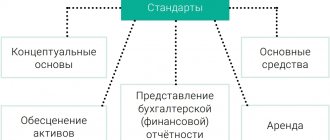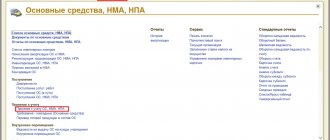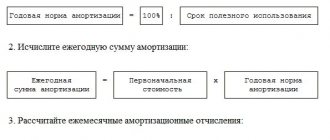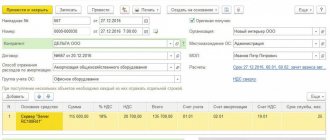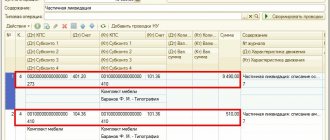Algorithm for calculating the depreciation coefficient of fixed assets
The depreciation ratio of fixed assets (hereinafter referred to as KAOS) shows how much the fixed assets of an enterprise are worn out and how soon they will have to be repaired or updated. This indicator is calculated using the formula
KAOS = A / PSt × 100,
Where:
A - depreciation (account balance 02);
PSt is the initial cost of fixed assets (account balance 01).
You can also use the data from Form 5 from the notes to the balance sheet to calculate this ratio.
For an algorithm for filling out Form 5, see the article “Filling out the Appendix to the Balance Sheet (Form 5).”
An example of a balance sheet can be found in the material “Procedure for compiling a balance sheet (example).”
In this case, KAOS will be equal to:
KAOS = page 5,200 (data on depreciation) / page 5,200 (data on original cost) × 100.
This indicator is calculated for a specific date, most often at the beginning and end of the year.
KAOS is a conditional indicator and depends on the chosen method of calculating depreciation. Let's look at how it will change in 2015 using an example (for clarity, let's agree that the company has only one OS).
Example
in January 2012 I bought a machine at a price of 578,470 rubles. (including VAT RUB 88,241.18). It was put into operation the same month. The period of use is 8 years. Production capacity - 500,000 units. for the expected service life.
Postings:
Dt 08 Kt 60 — 490,228.82 rub. - OS arrived;
Dt 19 Kt 60 - 88,241.18 rub. — VAT;
Dt 01 Kt 08 — 490,228.82 rub. — OS accepted for accounting.
SALT for account 01 for 2015:
| Beginning balance | Revolutions | Balance | |||
| Dt | CT | Dt | CT | Dt | CT |
| Machine | 490 228,82 | 490 228,82 | |||
On the procedure for calculating depreciation of fixed assets in 2013.
About the center » On the procedure for calculating depreciation of fixed assets in 2013. List of all questions and answers
Dear colleagues, please tell me how, according to the new rules, it is necessary to depreciate fixed assets put into operation in 2013? When and in what amount can bonus depreciation be applied? With respect and gratitude, Galina Dmitrievna Sazonova, Perm.
Dear Galina Dmitrievna!
Since 2013, it is possible to charge depreciation on real estate from the 1st day of the month following the date when the property was put into operation, this is not related to the submission of an application for registration of the property.
This is stated in paragraph 4 of Article 259 of the Tax Code of the Russian Federation (hereinafter referred to as the Tax Code of the Russian Federation).
Depreciation of vehicles also begins on the 1st day of the month following the day the facility was put into operation. Previously, to start depreciation, it was necessary to wait for state registration with the State Traffic Safety Inspectorate or Gostekhnadzor (for freight transport).
However, depreciation can only be calculated if the vehicle is actually used, which must be confirmed by waybills. It now takes 10 days to register a car with the traffic police. So, for example, if a car was purchased at the end of January and registered in February, then writing off depreciation amounts from its value can begin in February.
As for the depreciation bonus.
Having purchased a fixed asset, in tax accounting the organization has the right to immediately write off as expenses from 10 to 30% of its original cost, the so-called. depreciation bonus. The same rule applies to costs associated with the reconstruction or modernization of the operating system.
According to paragraph 3 of Article 272 of the Tax Code of the Russian Federation, the depreciation bonus is recognized as expenses: - when purchasing fixed assets - in the month when depreciation (i.e. in the month following the month of commissioning).
Since 2009, the amount of the depreciation bonus has been raised from 10 to 30% of the original cost in relation to fixed assets included in the 3rd - 7th depreciation groups, which includes fixed assets with a useful life of over 3 and up to 20 years inclusive.
Please note that the depreciation bonus does not apply to all fixed assets.
For example, bonus depreciation cannot be applied to fixed assets received free of charge. This is due to the fact that in this case the company does not incur acquisition costs.
The depreciation bonus is not accrued on fixed assets received as a contribution to the authorized capital.
But for property received under an exchange agreement, a depreciation bonus can be applied, since the costs of acquiring fixed assets occur: they are equal to the cost of goods (work, services) that are transferred in exchange for fixed assets.
According to the clarifications of the Ministry of Finance of the Russian Federation, given in letter No. 03-03-02/230 dated September 28, 2006, the depreciation bonus is taken into account only for tax accounting purposes ; the depreciation bonus is not reflected . In this regard, for organizations that have established in their accounting policies the right to a depreciation bonus, the accounting and tax accounting of depreciation will be different. In tax accounting, indirect expenses , reducing the tax base for income tax.
Application of the wear and tear coefficient of fixed assets in financial analysis
OSes play an important role in the life of an enterprise. Financiers use various techniques for a comprehensive analysis of fixed assets and the dynamics of their movement.
You will learn about methods of analyzing the balance sheet from the material “Methodology for analyzing the balance sheet of an enterprise.”
KAOS refers to indicators of the state of the OS. Most often, it is considered along with the OS serviceability coefficient (CGOS), which characterizes the technical condition of the OS and is expressed by the ratio of the residual value of the OS to the primary value. The higher the CGOS, the better the technical condition of the OS.
It is calculated according to the formula
KGOS = Co/Sp,
Where:
Co - residual (final) cost of fixed assets;
Sp - initial cost.
This indicator, like KAOS, depends on the depreciation method used and is conditional. In this regard, it is more advisable to compare the values of these indicators with the data of competitors or with the average value in the industry.
More details about the KGOS can be found in the article “Formula for calculating the serviceability coefficient of fixed assets.”
In addition to the above indicators, do not forget about the moral and physical indicators of the OS condition.
Obsolescence is the depreciation of assets due to technical and technological progress.
Physical wear and tear - material wear and tear under the influence of climatic conditions or during labor. This depreciation is subject to accounting and can be determined in 2 ways:
- by useful life (expected) use (depreciation);
- during a technical inspection of an OS facility.
The analysis must be carried out in dynamics. Based on the results, a conclusion is drawn about the degree of suitability and wear of the OS.
Valuation of financial assets.
Some financial instruments may be classified as either assets or liabilities, depending on the terms of the contract and current market conditions.
One example of such a financial instrument is derivatives.
Derivatives or 'derivatives' are financial instruments whose value is determined on the basis of some underlying factor (interest rate, exchange rate, commodity price, stock price or credit rating) and for which little or no no initial investment required.
A financial instrument is generally recognized when an entity becomes a party to a contract in relation to the relevant financial instrument. In general, there are two main alternative ways in which financial instruments are valued after initial acquisition:
- at fair value or
- at amortized cost.
Recall that fair value is the price that would be received to sell an asset or paid to transfer a liability in an orderly transaction between market participants at the measurement date.
See also:
- IFRS paragraph 13:9 Fair Value Measurements and US GAAP ASC 820.
- IFRS 13 - How to measure fair value under IFRS?
The amortized cost of a financial asset (or liability) is the amount at which it was initially recognized, less payments of principal, plus or minus the accumulated amortization of any discount or premium, and less any impairment.
See definition in IFRS 9 Financial Instruments.
That is, amortized cost reflects the historical or original cost of a financial asset .
Under IFRS, financial assets are measured at amortized cost (AMC) if the asset's cash flows arose as of stated dates and consist solely of principal and interest, and if the financial assets are held within a business model , the purpose of which is to hold assets to receive contractual cash flows ('held-to-collect' model) .
See also:
- IFRS paragraph 9:B4.1.2C et seq.
- IFRS 9 - Business Models
This concept is similar to US GAAP, where this category of assets is referred to as “held-to-maturity”, i.e. "held to maturity" .
An example would be investing in long-term bonds issued by another company or government. The value of bonds will fluctuate, for example, as interest rates change, but if the bond is classified as a held-to-maturity investment, it will be valued at amortized cost on the investing company's balance sheet.
Other types of financial assets measured at historical cost are loans to other companies.
Financial assets that are not measured at amortized cost upon acquisition are measured at fair value at the reporting date. For financial instruments measured at fair value, there are two main alternatives to recognizing changes in fair value:
- as profit or loss in the income statement or
- as part of other comprehensive income (loss), outside the income statement.
Note that these alternatives relate to the unrealized change in fair value, that is, the change in the value of a financial asset that has not been sold and is still held (owned by the entity) at the end of the period.
Unrealized gains and losses are also called 'holding period gains and losses' .
If a financial asset is sold during the period, then:
- profit if the selling price exceeds the book value and
- loss if the sale price is less than the book value.
When a financial asset is sold, any realized gain or loss is recognized in the income statement.
What does a high depreciation ratio mean?
Analysts identify 2 possible reasons for increased KAOS:
- the funds are really very worn out;
- depreciation is written off using an acceleration factor.
In practice, financiers use KAOS as an indicator of the risk of failures in the production process. Accordingly, if the indicator is too high, the analyst will conclude that there is a high risk of interruption of the production process and the need for repair or modernization of equipment.
But accounting assumes the possibility of using a mechanism for accelerated depreciation of fixed assets. In this case, the accounting depreciation will significantly exceed the actual one. Accordingly, the analysis should reflect relevant comments to report users.
Results
The depreciation rate of fixed assets is used in conjunction with similar indicators to analyze the state of the company's fixed assets. This indicator is conditional and fundamentally depends on the depreciation write-off method chosen by the company. If it is too high, then, according to analysts, there is a high probability of a workflow failure and the OS needs to be upgraded.
You can find more complete information on the topic in ConsultantPlus. Free trial access to the system for 2 days.



